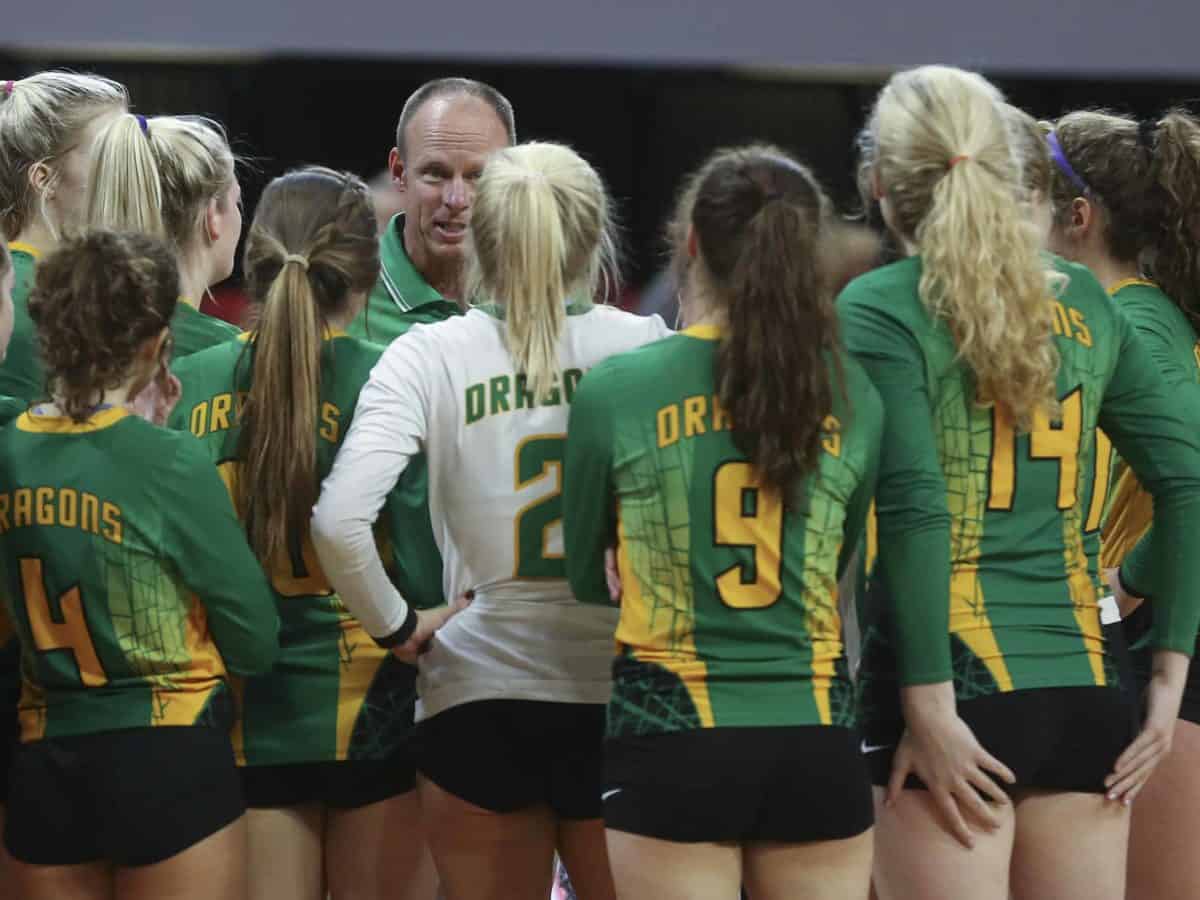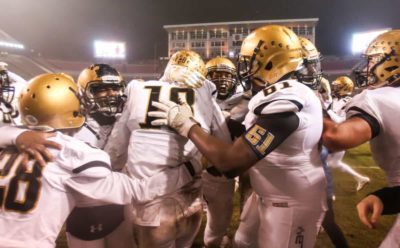
The lights flicker on, humming momentarily before growing brighter by the second.
Hot dogs find their way to a grill, soon to be topped with ketchup, chili, and slaw (and nothing else, if you’re doing it right), and brown paper bags are ready for just a bit more popcorn than they can hold.
In a nearby parking lot, the band warms up, preparing to kick off the night’s festivities. Soon, the smell of cut grass mixed with sweat will fill the air.
The sights, sounds, and smells of high school football are plentiful, and in many communities across North Carolina, they represent a slice of Americana worth holding onto.
In the rolling hills of the Piedmont, thanks to a new school and the latest iteration of a proud conference, Friday nights are better than ever.
When the N.C. High School Athletic Association undertook the every-four-year root canal of reclassification prior to the 2017-18 school year, there was a big change coming in Davidson County.
Oak Grove High School (in Midway) was set to open, the first new school in the Davidson County Schools district since 1963. The school’s opening would have a big impact — it siphoned students away from both Ledford High School (in Wallburg) and North Davidson High School (in Welcome), meaning both would become 2A programs.
And it meant that the Central Carolina Conference would become a 10-team behemoth featuring traditional powers in both Davidson and Rowan counties. Gone are the days when North Davidson would travel into Davie and Forsyth counties for matchups with Winston-Salem schools like Mount Tabor, Parkland, and others. Thomasville would no longer head east for games against Chatham Central, North Moore, or Jordan-Matthews.
The newest iteration of the Central Carolina Conference would be a throwback of sorts, renewing rivalries among some county schools that haven’t always played each other frequently.
Initial reaction to the change was overwhelmingly positive, and two years later, it has stayed that way. Game attendance is up, the number of long road trips is down and the new CCC is full of competition.
“Gate attendance has increased with the addition of North Davidson, Oak Grove, and Ledford to the traditional Davidson County 2A schools,” Charles Elmore, the athletics director for Davidson County Schools, said recently. “North and Ledford have been dominant (in football), but as other schools raise their level of play, attendance should only increase.”
Football attendance plays a key role for every athletic program in the state, as ticket and concession sales help fund efforts on the gridiron and beyond.
Thomasville Athletics Director Steve Bare said Davidson County’s history helps fuel interest and put fannies in the stands.
“The difference in attendance has been a very positive change,” he said. “At Thomasville, our average gate for all ticketed sports has improved significantly with this new conference alignment.”
Clayton Trivett, the head football coach at Central Davidson High School and a Thomasville High School alum, said he’s also noticed an increase in crowd sizes.
“The addition of North Davidson and Ledford has helped attendance at games and brought back some of the rivalries that used to be there,” he said.
There’s no way around it — geography matters when it comes to building rivalries.
It also matters when it comes to building travel budgets. Central Carolina Conference members (and their fans) have enjoyed less travel overall.
Bare said 80 percent of Thomasville’s travel is within 30 minutes of its campus. During the dozen or so years Thomasville spent in the Yadkin Valley 1A Conference in the late 1990s and early 2000s, the Bulldogs consistently traveled more than an hour for road games. That’s tough enough on Fridays during football season, but it’s even more of a hassle in other sports, where midweek games are the norm.
There are a handful of long trips for CCC teams, but even the longest is only about 45 to 50 minutes; South Rowan High School is a little more than 40 miles from Ledford High School.
But is bigger … better?
While athletic directors and coaches in the CCC agree that this version of the league is good for fans and competition, there is a downside to a 10-team conference: jockeying for playoff position gets tougher.
In football, for example, a good team can finish in the middle of the pack and miss the postseason altogether.
“Based on MaxPreps rankings, our number five has been within the top 64 several times and has not qualified for the playoffs,” Elmore said. “In many of our sports, you can be a really competitive team and finish in the middle of the pack.”
Facing good competition all year long prepares teams for what’s to come in the playoffs, perhaps giving those squads that do make the cut a better chance of making deep runs. But finishing in the middle of a large, competitive league usually means hitting the road come playoff time, and that’s never easy.
This season, league champ Ledford (11-1, 9-0) and runner-up North Davidson (10-2, 8-1) both won first- and second-round playoff games and will play again Friday. Top-seeded Ledford will get to enjoy being at home all the way through the 2AA bracket.
But third-place Salisbury (7-5, 7-2), fourth-place Thomasville (8-4, 6-3), and fifth-place Lexington (5-7, 4-5) all traveled in the first round — and all three teams were bounced.
A year ago, after winning the league, North Davidson advanced to the 2AA regional final after securing the No. 2 seed and enjoying home games throughout November.
Thomasville’s Bare said he sees the size of the conference as both positive and challenging.
“It’s an opportunity because there may be higher-seeded schools who will not have faced the type of competition our Central Carolina Conference members have seen in conference play,” he said.
NCHSAA Assistant Commissioner James Alverson said the association aims for conferences between six and eight schools depending on a number of factors, including geography, travel logistics, and more. Among 2A leagues, the Central Carolina Conference and Three Rivers Conference, which each have 10 teams, are the outliers. The remaining 2A conferences all have six, seven, or eight teams.
“You don’t end up with the ideal conference size all the time. Geography plays a big part in it, and schools do have a voice during the realignment period,” Alverson said.
Speaking of realignment
It’s no secret that realignment is tough.
Every four years, it takes a committee, multiple meetings and drafts, and plenty of additional conversations to sort the state’s high schools into conferences that make sense.
The goals of the NCHSAA’s realignment committee are fairly simple: to “align member schools into conferences or like sizes relative to average daily membership and close geographic proximity, with minimizing travel as a primary consideration.”
When the 2017-2021 process began, Oak Grove hadn’t yet opened, and it was a bit unclear which teams might end up in the Central Carolina Conference. An initial draft of 2A leagues placed Thomasville in a Randolph County-based league with schools like Trinity, Randleman, and Eastern Randolph.
Bare said he hoped for a change, so he lobbied the old members of the CCC, along with incoming new members, to make sure the Bulldogs ended up in the conference he felt was best suited for them. A second draft still put Thomasville in the PAC-7, but eventually, the Bulldogs ended up in the CCC.
“It wasn’t about the (Randolph County) group as much as what we felt we were being left out of. The latest version of the CCC included all 2A schools in Davidson County except Thomasville. That was our biggest point of contention,” Bare said. “We didn’t feel that it was equitable for Ledford and East Davidson to drive right by our school to play each other without being in the same conference. Fortunately for Thomasville, we found some great support within the group who stepped up on our behalf with the NCHSAA.”
Elmore said many of the other CCC schools supported the addition of the Bulldogs and Yellow Jackets, which made it easier to appeal to the NCHSAA.
“My focus will always be to work to keep as many Davidson County schools together as possible,” he said. “In the last round, it made sense to include Lexington and Thomasville because they are in the county, are a similar size and have been grouped together to help us form a middle school athletic conference. We know each other well.”
Alverson said the current version of the league is a good example of how the realignment process works in a broader sense. There is plenty of discussion among member schools and the association, and in general, everyone is hoping to make logical decisions.
“There is some give and take. In general, you want to keep schools close to their conference opponents,” Alverson said. “When you get into the appeals process, the key is having an agreement with a conference that is OK with you leaving and a conference that is OK with you joining.”
CCC members are certainly enjoying the current version of the league and all of the advantages of playing your nearby rivals, but only time will tell if the 10-team league stays that way.
Who knows, maybe the NCHSAA will view this success story as a template to be used in other parts of the state. Is there an opportunity to create more superconferences? Should the standard be to group together as many teams from as few counties as possible to maximize ticket revenue and minimize travel costs for those member schools?
We will see soon. The next round of realignment is right around the corner since the process starts back next fall.

